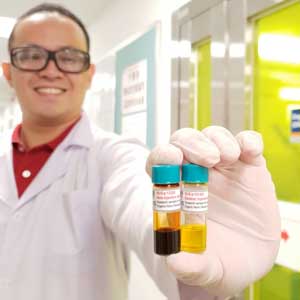| Oct 04, 2019 | |
Universal latent anion donors for ultralow work function solution-processable electrodes(Nanowerk News) National University of Singapore (NUS) scientists have reported in Nature ("Multivalent anions as universal latent electron donors") the discovery of latent universal electron donors from common anions, like oxalate, which can potently transfer electrons to organic semiconductors, realising the dream to achieve electron injection layers with ultralow work functions which can yet be processed from solution in the ambient. |
|
| This is expected to open many new possibilities, not only for organic electronics, but also other advanced semiconductors, including quantum dots, nanowires, two-dimensional (2D) materials, and perovskites. | |
| The work function of a material is the minimum amount of energy required to remove the least tightly-bound electron to vacuum. This determines the ability of that material to inject electrons into a semiconductor. | |
| Electron injection layers require a sufficiently low work function, preferably much smaller than 4 electron-volts, to efficiently inject into (and collect) electrons from many novel semiconductors. | |
| However this typically requires evaporating thin films of reactive metals in vacuum conditions, which limits device architecture, processability, and manufacturability. Ultralow work function materials become degraded by exposure to air. | |
| Now, the Chemistry team led by Prof Lay-Lay CHUA, and Physics teams led by Dr Rui-Qi PNG and Prof Peter HO, from the Organic Nano Device Laboratory, NUS have demonstrated that multivalent anions, such as oxalate, carbonate and sulfite, can act as powerful latent electron donors, when they are dispersed as small ion clusters in a polymer matrix of suitable conjugate polyelectrolytes. | |
 |
|
| Image shows Mr KOH Qi-Mian holding solution samples of hole- (left) and electron-injection (right) materials that are ready for solution-processing in ambient to make electrodes for semiconductor devices. (Image: NUS) | |
| Conjugated polyelectrolytes are polymers with ionic side groups and delocalised electrons in the backbone. Crucially, the mixture can be processed from solution in air, and the anion spontaneously transfers electrons to the polymer host only after drying, thereby serendipitously protecting the material from atmospheric degradation. | |
| With the appropriate polyelectrolyte host, work functions as low as 2.4 electron-volts have been attained, overcoming the long-standing conundrum to marry ultralow work function materials with solution processing. The research team has demonstrated the versatility of this discovery by making a variety of high-performance white-light-emitting diodes and organic solar cells using solution-processed electron-injection layers. | |
| “Unlike precursor dopants, these anions do not require chemical transformation to become active,” Dr Png explained. “They work because the repulsion between electrons in these anions causes their electron donor level to remain high, even in the solid state, when they become dehydrated. Together with careful design of the polyelectrolyte host, we can achieve ultralow work function materials previously not thought possible.” | |
| Prof Chua said, “This work extends, and leverages on, the self-compensated charge-doped polymer platform that we pioneered three years ago.” She added, “It was a delightful surprise of nature that such simple anions can be harnessed to accomplish what has been the holy grail of this field for the last two decades!” | |
| The teams are currently working with industry and academic partners to extend the approach to other types of devices, and to establish the technology. |
| Source: National University of Singapore | |
|
Subscribe to a free copy of one of our daily Nanowerk Newsletter Email Digests with a compilation of all of the day's news. |
